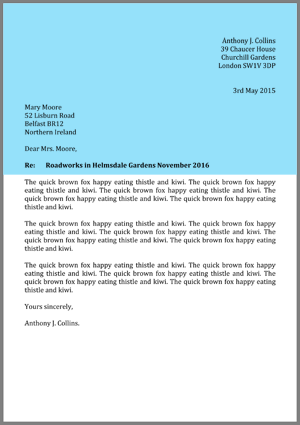When writing a letter, the sender’s address always goes in the top right-hand corner of the page. For an email this is not necessary. Underneath our address, we put the date in full form. This means we don’t write ‘3/05/2015’, but ‘3rd May 2015’. On the other side of the page, we put the recipient’s address, drawing an imaginary line from the date and beginning on a new line on the other side of the page. It should look something like this:

The salutation is important. If we don’t know the name of the person we are writing to, we write the job title (if known), for example ‘Dear Head of Human Resources’. If we don’t know their name or job title, we write ‘Dear Sir/Madam’, or ‘To whom it may concern’. We follow this with a comma, and never a colon (:). If we know the name of the person we are writing to, it is important to use the correct title. We use the surname, and not the person’s first name.
Man = Mr.
Woman who is unmarried = Miss.
Woman who is married = Mrs.
Woman whose marital status is unknown or wishes it not to be known = Ms.
With women, if you are unsure, use Ms. It will cause the least offence! Therefore, if we are writing to someone called John Smith, we will write ‘Dear Mr Smith,’.
Then comes the introduction. We include an introduction paragraph to tell the reader what they are going to be reading about. The introduction doesn’t need to be long. Use phrases such as…
‘I am writing to inform you about/of…’
‘I wish to make a complaint regarding…’
‘I am writing to thank you for your offer regarding…’
‘I am writing to accept your invitation to…’
Notice that we use the present continuous tense in letters, because it is happening NOW, at the time of writing. This tense is used commonly in emails and letters.
We then include the main text. Separate your ideas with paragraphs, which should be short and to the point. If you are unsure as to whether to start a new paragraph, start one anyway. This means your paragraphs will not get too long. Paragraphs need to be separated by a blank line, not solid text.
Conclude the email or letter with the appropriate ending. If you are writing to ask someone to do something for you, always thank them in advance.
‘I appreciate your advice on this matter and await your prompt response’.
‘Thank you for your consideration and please let me know should you require any further information’.
‘Looking forward to meeting you soon’.
If you don’t know the name of the person you are writing to, you need to end with ‘Yours Faithfully’, and then sign your name. If you do know the name of the person you are writing to, use ‘Yours Sincerely’. If the email or letter is less formal, you can use ‘Kind regards’. In all situations, we can generally use ‘Best regards’.
Check that your grammar and spelling are accurate. Do not use ‘can’ when asking for something, use the more formally appropriate ‘could’. ‘Should’ is often preferred instead of ‘if’ (e.g Should you wish to contact me, my telephone number is…). Try not to repeat the same kind of information again and again. While the language is formal, don’t get carried away with your pleases and thank yous!
Now that you are informed, don’t be shy when writing letters!
E. Lawrenson
- Abierta Inscripción Cursos de inglés – Invierno 2017 - 20 diciembre, 2016
- Growing Up With Grammar. Prepare Your Exam Seminar - 1 diciembre, 2016
- Tips and Advice: Prepare your Exams (2) - 24 noviembre, 2016
Ven a conocer la escuela y haz una prueba de nivel gratuita
 Recursos gratuitos de inglés
Recursos gratuitos de inglés